
MAY CONTAIN NUTS

Search Shorpy
SHORPY ART

Framed or unframed, desk size to sofa size, printed by us in Arizona and Alabama since 2007. Explore now.
Join and Share
Ad-Free Shorpy
Shorpy is funded by you. Patreon contributors get an ad-free experience.
Learn more.

Recent comments
- What a headache!
- Baldwin 62303
- Baldwin VO-1000
- Cold
- No expense spared
- Tough Guys
- Lost in Toyland
- And without gloves
- If I were a blindfolded time traveler
- Smoke Consumer Also Cooks
- Oh that stove!
- Possibly still there?
- What?!?
- $100 Reward
- Freeze Frame
- Texas Flyer wanted
- Just a Year Too Soon
- WWII -- Replacing men with women at the railroad crossing.
- Yes, Icing
- You kids drive me nuts!
- NOT An Easy Job
- I wonder
- Just add window boxes
- Icing Platform?
- Indiana Harbor Belt abides
- Freezing haze
- Corrections (for those who care)
- C&NW at Nelson
- Fallen Flags
- A dangerous job made worse
Member Photos
The Shorpy
Print Emporium
Print Emporium
Search Shorpy
Search results -- 30 results per page
- Egg Rollers: 1911
- "Easter egg rolling at White House, 1911." Harris & Ewing. View full size.
Litterbugs Apparently ... back then too ...
Washington Post, Apr 17, 1911
Kiddies to Roll Eggs Today
President May Speak to ... Posted by Dave - 08/23/2012 - 6:17pm -
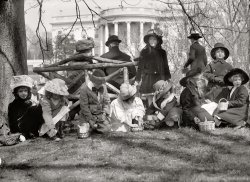
- Red Widow: 1911
- New York circa 1911. "Times Square at night." Now playing at the Astor: Raymond Hitchcock as ... Posted by Dave - 07/29/2012 - 1:28pm -
![Red Widow: 1911 New York circa 1911. "Times Square at night." Now playing at the Astor: Raymond Hitchcock as Cicero Hannibal Butts in the musical comedy "Red Widow." 8x10 inch glass negative, Detroit Publishing Company. View full size.
Pity the poor commaAbused here in the Evans' Pastilles sign:
FOR COLD'S COUGH'S HOARSENESS.
Some things never change!
[Pity the poor apostrophe -- so often confused with the comma! - Dave]
Why Every Citizen Should Read the ChiefUpper right hand corner has a billboard for New York's Civil Service newspaper, still published today, with the same masthead.
Only in the bizarro Shorpy worldWould it were possible that the character Cicero Hannibal Butts was the great-grandfather of today's real-life stage actor Norbert Leo Butts!
Hail to The ChiefThe Independent Voice of New York City Civil Service Since 1897, so they say. Still publishing once a week, it was the place to check for info on government jobs in the NYC area before the Internets started laying down their tubes.
Same View--Seven Years laterThis is the same view as found in this post but several years later. Looks like the Packard dealer didn't make it.
https://www.shorpy.com/node/7407
IncredibleCompared to the non-stop intense sounds of Times Square today, that region looks to have been quiet, even peaceful during the time this picture was taken. Well, peaceful might be a stretch unless you closed your eyes to shield from the already dominant presence of light displays.
I love both New Yorks.
+99Below is the same view south from 45th Street taken in April of 2010.
A Daunting ChallengeMaking a silent movie that's a musical comedy would be quite a challenge, I'd expect.
[It would be, and it's not a movie. - Dave]
Historical Photos Moments caught on camera that will never be seen again. I love old photos~
Wow! This I really like.What a fantastic and almost unbelievable contrast to today!
ChiropodistIt's almost seven at night. Must be autumn?
I'm wondering what a Chiropodist was? Someone who cracks your spine with his feet? Someone who handles feet?
Endearing Times SquareFrom the halo glow of the Hotel sign atop the building to the plethora of illuminated signs, what a treat this magical place is. The automobiles look almost 3D like and so in focus. It's only 9:35 and the night is still young.
How about those cool lanterns on their standards. Oh New York, New York.
Two cabs, no waitingIdle taxis waiting for customers at the hack stand. And the chiropodist -- my mom went to one in the 1950s to get her aching feet checked. Great picture.
Match Game '11Amazing to see how quickly electric lighting became commonplace, and how things looked in the era before neon, although if Wikipedia is correct neon lighting was demonstrated in Paris shortly before this photo was taken.
I see the Match Game is on at the billiard parlor. Probably where Brett Somers made her debut.
Louis MartinsVisible on 42nd Street are signs for both the Broadway and Seventh Avenue entrances for this 5,000 seat restaurant and lobster palace. It was the reincarnation of the elaborate but ill-fated Cafe de l'Opera, which failed when it required evening wear, and served food that cooled during the long trip from the kitchen.
The Great White WayWas bright as it ever was in 1910.
Times Square: The PaintingThe remains of a Chancellor Cigar poster from a drugstore. It took me years to find it depicted Times Square. There's a subway entrance depicted in the right half. I couldn't discern whether there is a similar structure in the photo.
ChiropodyThe Chiropodist treated both hand and foot.
Chiropody, and emptinessYes, a chiropodist is someone who handles feet - specifically, treats things like bunions, corns etc. They're still known as such in the UK (I think they're podiatrists now in the US but I might be wrong!)
I love the cars/taxis! And how empty it looks. I've never seen it like that. Was it realyl short exposure so all the people are blurred and not really visible?
(The Gallery, DPC, NYC)](https://www.shorpy.com/files/images/4a25604a.thumbnail.jpg)
- Twelve Horsepower: 1911
- ... Transfer & Storage Co., Washington, D.C." In 1911, moving a boiler on D Street within sight of the Capitol with a 12-horse ...
Must of wore them plumb out From the March 5, 1911 edition of The Washington Times :
(The Gallery, D.C., Harris + ... Posted by Dave - 08/12/2014 - 12:51pm -
![Twelve Horsepower: 1911 "Merchants Transfer & Storage Co., Washington, D.C." In 1911, moving a boiler on D Street within sight of the Capitol with a 12-horse team. Bonus: Many old billboards. Harris & Ewing Collection glass negative. View full size.
Shucks!My fingers tell me there are but ten horses.
[Maybe you should stop listening to your fingers. - Dave]
Cheap buzzSix beers for a quarter should just about do it. Is the bar open yet?
Twelve?Upon a cursory look, I only spy ten horses.
[2 + 2 + 3 + 3 + 2 = 12 - Dave]
I agree but a cursory look should exonerate me from this foo-pah...
Spare Horses?Unless there a pair of horses bringing up the rear and out of view -- I only see 10 horses (5 pairs).
[See below, and above. A more interesting question might be: What is the cross street here? - Dave]
ThreeThere looks to be three horses in the second bunch from the right, but nowhere else.
[Three heads plus six forelegs = three horses in the middle group, too. - Dave]
Military precisionAll those horses have their front hooves together but one slacker in the rear. That makes it easy to count but is that boiler full of water requiring lots of horse power or are they going a long way?
D Street and Delaware Ave SWThe Statue of Freedom atop the Capitol faces east, and we're a little off the diagonal from the top of the Capitol and the SW corner of the building. The view from the same spot today is blocked by the Rayburn House Office Building.
There Are Clearly 10Even in the "close up" from mailman7777777 you can clearly see that there are 2 horses not 3. Unless the horses are magical semi-transparent horses.
What is 3 is just a horse that moved a bit in a long exposure.
Come on people!
[Horse 3 has a noseband, horse 2 does not. The exposure wasn't long enough for horse 1 to have moved that far. Horse 3 merely bobbed its head quickly during the exposure. Dave posted the closeup. -tterrace]
[There are also three horses in the second group from the right -- three rumps and three tails at one end, and three necks and six ears at the other. Sarabellum might also want to count the legs.- Dave]
Yep, TwelveYou can see the nose band on the blurred nose of the middle horse in the second team of three and three pairs of hames in the first triple team. It's an odd setup, usually seen only on fire engine teams, but what probably happened was they needed the added horsepower, but the two extra horses may not have teamed well together but worked well with the other teams. Normally, teamsters would have simply doubled the wheel team (closest to the the load). I guess they had their reasons for this configuration. It may be that those middle teams tended to drift and the third horses were there to keep them straight. I noticed that the only mounted driver is on the wheel team. Often there would be at least another driver on the near lead horse. In the old horse drawn artillery, there was a driver on each pair.
Oversize Load, 1.0Very impressive example of the way large loads were moved back in the day. And no signs were needed to indicate the obvious, either.
Delaware AvenueThe cross street is most likely Delaware Avenue. The Statue of Freedom on the dome faces east, which means we're on the south side of the Capitol (remember, there's a D Street on the north side, too). The cross street aims directly at the southwest corner of the Capitol Building, which, if it still extended that far, Delaware Avenue would do. The majority of the road is gone now. It is a huge parking lot to the southwest and the Rayburn House Office Building to the Northeast. What remains of it is a security screening area for delivery trucks waiting to enter the loading docks of one of the house office buildings.
CameoDid anyone else notice the Alfred Hitchcock lookalike looking out from behind the bars of the window in the bar?
But Wait - There's More!What is the large pole (leading out of the picture to the left) for? The fellow sitting on the pole would seem to suggest that it is well supported out of the picture.
Now That's Entertainment!One of the many things that make SHORPY such a great site is the interaction of the commenters and Dave and tterrace. Not only do we get to see great old pictures, but on occasion we become privy to folks getting confused, or being mistaken, or just plain flummoxed by the pictures.
Such fun!
SHORPY is always good entertainment; always good for a grin, or a chuckle, or a good ol' belly laugh! Thank you to all the commenters for their input, whether confused or not. You make the day for so many people.
And to Dave and tterrace, keep the pictures and the comments coming!
BaseballLooks like perhaps that group of boys behind the horses, stopped their baseball game to gaze on all of that horsepower. Either that, or they lost their baseball diamond with all of the commotion. (For what it's worth, I think there might be a 13th horse in the second group from the back... an awful lot of legs. But perhaps they are ghost legs).
More than meets the eyeBut wait asked: What is the large pole (leading out of the picture to the left) for?
I think it is part of the wagon and there is more to this drayage than meets the eye, or fits in the picture. There could be a second boiler or more parts in another wagon connected to the visible wagon via said pole.
But Wait, There's More...Based on the method of attachment to the pole under the first boiler trailer, the pole could be easily used to attach a 2nd trailer.
Large PoleTo me it looks like the long pole the guy is sitting on is part of the trailer. The rear axle is adjustable for longer loads.
The PoleLook at the undercarriage parts in front of the rear wheels...the pole is actually an adjustable chassis/backbone for the wagon, which seems to be adjustable for a load at least twice as long as the boiler with that particular pole. The pole seems adequately supported by the attachments to the axles and held up by the colossal weight of the load.
You can see a simple holder there with what amounts to two huge hoseclamps to hang the axle unit onto the pole. I'm guessing that this is a seldom-used rig for the most awkward loads, and that it was disassembled for storage when not needed.
Extended truck "log" frame under wagon.Signalman noticed that log to the left. Looking under the wagon you can see the adjustable collar used to extend or shorten the overall wagon length.
This was a heavy haul wagon to start with based on the wheel rim, spoke, and axle sizing. No brakes either, though city hauls would be fairly level and some of the helpers might have been carrying wheel chocks to slow it down during downhill travel.
Coatesville Boiler WorksHaving grown up just next to Coatesville, the town name on the new boiler was the first thing to catch my eye.
The boiler works was most likely associated with (or at least bought their boilerplate from) Lukens Steel, which to this day is the oldest steel mill in commission within the United States.
MoreGreat photo. As a retired structural engineer I would like to see more photos of turn-of-the-19th-century construction sites when the predominant power sources were men, horses and mules.
Must of wore them plumb outFrom the March 5, 1911 edition of The Washington Times:
(The Gallery, D.C., Harris + Ewing, Horses)](https://www.shorpy.com/files/images/SHORPY-15962a.thumbnail.jpg)
- Big Annimated Show: 1911
- Circa 1911. "Main Street, Buffalo, N.Y." Our idiosyncratically spelled title comes ... "The Revenue Man And The Girl" was released on 9/25/1911.
One of the players was a young Mabel Normand. It was filmed in the ... Posted by Dave - 06/20/2017 - 11:36pm -
![Big Annimated Show: 1911 Circa 1911. "Main Street, Buffalo, N.Y." Our idiosyncratically spelled title comes from the marquee at the Hippodrome. Now playing: The Revenue Man and the Girl. 8x10 inch glass negative, Detroit Publishing Company. View full size.
"Make no little plans"said Daniel Burnham, the architect of the magnificent Italian Renaissance Ellicott Square Building in the center of the picture.
Recently restored (except for the missing terracotta cornice and lion heads), at the time of this picture it had been relegated to only being the second largest office building in the world.
https://en.wikipedia.org/wiki/Ellicott_Square_Building
Hippodrome TheatreAccording to Wikipedia, Shea's Hippodrome theatre was opened in 1914 at 580 Main St.
[This Hippodrome isn't Shea's Hippodrome, which looked like this. -tterrace]
An early DW Griffith film"The Revenue Man And The Girl" was released on 9/25/1911.
One of the players was a young Mabel Normand. It was filmed in the wilds of New Jersey!
Michael Shea's Hippodrome did not open until 1914. Afterwards, this theater at 263 Main St., was then known as the Little Hippodrome. It closed in 1962 and was razed shortly after.
+111Below is the same view from September of 2022
(The Gallery, Buffalo NY, DPC, Movies, Stores & Markets)](https://www.shorpy.com/files/images/SHORPY-4a24351a.thumbnail.jpg)
- Spoiled Nan: 1911
- Eastport, Maine. August 1911. "Nan de Gallant, 4 Clark Street, 9 year old cartoner, Seacoast Canning ... lose her arm. Another photo of Nan, also taken in August 1911:
Nan 4 Thanks for the second look, I felt bad for a few ... 5 Clark, the blue-greenish house, may be a survivor from 1911; it's hard to tell. This old photo makes it look more like a lane than a ... Posted by Dave - 09/07/2011 - 10:28pm -
![Spoiled Nan: 1911 Eastport, Maine. August 1911. "Nan de Gallant, 4 Clark Street, 9 year old cartoner, Seacoast Canning Co., Factory #2. Packs some with her mother. Mother and two sisters work in factory. One sister has made $7 in one day. During the rush season, the women begin work at 7 a.m., and at times work until midnight. Brother works on boats. The family comes from Perry, Maine, just for the summer months. Work is very irregular. Nan is already a spoiled child." View full size. Lewis W. Hine.
Nanper the look on her face, she heard somebody calling her a spoiled child
Nan 2As I look a second time, I think she is mad at me!!!!
[Maybe she was a forum moderator???? - Dave]
Spoiled Nan ...is a constant problem in Bangalore during the summer.
Nan 3Is she hiding something behind her back?
Behind Her backI think she's hiding a Glock 9. Perhaps a little something for the photographer?
She's lost her arm at the factory.The comment that she is spoiled has a very different meaning than we assume today. Nan is not a brat. She has lost a limb in the canning plant, and thus is spoiled from being fit for productive labor.
[She did not lose her arm. See photo above. - Dave]
Spoiled Nan and Her ArmShe didn't lose her arm. Another photo of Nan, also taken in August 1911:
Nan 4Thanks for the second look, I felt bad for a few minutes
Strange but...The girl behind Nan definitely looks like her head is on backwards!
Clark StreetIf this photo was taken on Clark Street and Nan is standing in front of #4, it's not there anymore. Looks like Clark has been widened quite a bit, as well. Number 5 Clark, the blue-greenish house, may be a survivor from 1911; it's hard to tell. This old photo makes it look more like a lane than a street, but both the old view and this GoogleMaps view terminate at the water - or, what might be termed a landing, so who can say for sure?
View Larger Map
Carrie: The Early YearsThis photo looks like it belongs as a book cover on a Stephen King novel. That girl's look is absolutely wicked.
(The Gallery, Kids, Lewis Hine)](https://www.shorpy.com/files/images/00932u.thumbnail.jpg)
- Young FDR: 1911
- Franklin Roosevelt in a portrait dated February 3, 1911, a few days after his 29th birthday. View full size. George Grantham ... I think he has pretty amazing glasses for it being 1911. Do they stay on just by being pinched on the nose?
Pince-Nez Yup! ... Posted by Dave - 09/07/2011 - 10:39pm -
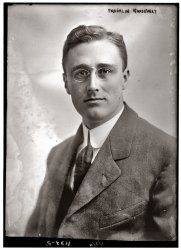
- The Smiths: 1911
- May 1911. West Point, Mississippi. "Dependent (able-bodied) Parents. Smith family. ... Trying to provide for a family of eight or nine or more in 1911 didn't leave much time for Better Homes and Gardens. Of course maybe he ... Posted by Dave - 09/22/2011 - 8:43pm -
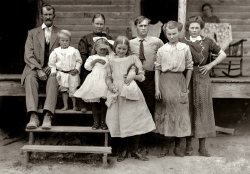
- West Side Cowboy: 1911
- ... the New York Central's Eleventh Avenue freight line circa 1911. In a 1930 article on the West Side tracks' demise, the New York Times ... buildings, 32 and 34 10th Avenue, is Plate 10 of the 1911 Atlas. This building faces the marginal street by the Hudson River piers ... Posted by Dave - 09/08/2011 - 7:26pm -
![West Side Cowboy: 1911 Equestrian signalman on the New York Central's Eleventh Avenue freight line circa 1911. In a 1930 article on the West Side tracks' demise, the New York Times wrote of the "eight men and twenty-four horses comprising the famous 'cowboy troop' [or 'West Side Cowboys'] whose function it has been for years to ride ahead of the puffing locomotives as they wheeled along Death Avenue." The dangerous street-level tracks were eventually replaced by a 1½-mile viaduct, the High Line, that after decades of abandonment is being turned into a long, thin elevated park. View full size. 5x7 glass negative, George Grantham Bain Collection.
Pegleg?Does the man in the right-hand background have a peg instead of a foot?
[Could be. - Dave]
Actually...Peg was his wife; his name was Ben; Ben Cobble. No, really.
Peg leg?I think he does have a pegleg.
11th Avenue LineI have been looking into the locations of the "11th Avenue" photos and think that this one is also on 10th Avenue, though much lower than the other two. This one is at 13th Street, looking south (see "13th Street Market" wording on awning). Eleventh avenue doesn't even exist this far south. The map showing these buildings, 32 and 34 10th Avenue, is Plate 10 of the 1911 Atlas. This building faces the marginal street by the Hudson River piers which had just been renovated in the decade-long "Chelsea Improvement" that enabled very large ships to dock. In 1912, Cunard's Pier 54 across the street from this building would welcome the ship Carpathia after she disembarked Titanic lifeboats and survivors at White Star Pier 59. In May of 1915 the Lusitania departed from Pier 54 on her final voyage. This location is now the west side of the luxury Standard Hotel.
This photo of the arrival of Lusitania on her maiden voyage in 1907 (before the completion of proper pier sheds) appears to have been taken from the roof of this building or one nearby.
[I'd say the labels on the negatives reflect the fact that the line was called the 11th Avenue Railroad because that's where most of it was, or at least the most dangerous part was, even if stretches of it were on other streets. - Dave]
About that cowboyCalling them "cowboys" was the railroad's attempt at being polite. The locals called them "dummy boys" as they led the shrouded steam locomotives, called "steam dummies" so as not to spook the local horses. Grandfather and cousin told me a few stories about those guys.
ObservationsStarting at bottom right and moving up through the picture, before ending apparently under the boxcars, we have the remnants of a former trolley line. Since much of NYC disallowed the use of overhead wires and instead used the "slot" system, we can tell this line is somewhat recently abandoned. The rails have been removed, with them and the "slot" filled in by bricks.
Looking at the path of the former streetcar line, we can see that at some point it would have passed up by the Strauch brothers building, probably connecting with another line at the far end of the triangle shaped area.
The Swift company used overhead loading tracks to move goods from the cars and into the shop or vice versa. You can barely make out this system under the awning.
Whereas most steam dummies were Shay-type geared locomotives, this one predates that and is a squat Tank type.
(The Gallery, G.G. Bain, Horses, NYC, Railroads)](https://www.shorpy.com/files/images/02886u.thumbnail.jpg)
- S.S. Olympic: 1911
- New York. June 21, 1911. "White Star liner S.S. Olympic guided in by tugboats Geo. K. ... ends, Olympic's worst event in her 24-year career was her 1911 collision with the British warship HMS Hawke in the Solent (the strait ... Posted by Dave - 07/18/2012 - 7:05pm -
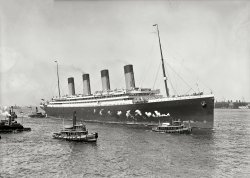
- Euclid Avenue: 1911
- Cleveland, Ohio, circa 1911. "Euclid Avenue, east from Public Square." A close-up of the greenery at ... quadrennial and 12th international convention) in July 1911. - Dave]
MACCABEES ARE IN CAMP
UNIFORM RANK DELEGATES ... Posted by Dave - 07/30/2012 - 10:52pm -
![Euclid Avenue: 1911 Cleveland, Ohio, circa 1911. "Euclid Avenue, east from Public Square." A close-up of the greenery at the base of the Soldiers' and Sailors' Monument seen in the previous post. 8x10 inch glass negative, Detroit Publishing Co. View full size.
Working on the streetcar lineI love the guy on a ladder, apparently brought by a cart pulled by a horse, working on the streetcar line. I can imagine the old timers complaining about those new fangled electric car lines, as opposed to the good old fashioned ones pulled by horses or donkeys.
Problem solvedI had to wonder what the designs of the various flower beds were, they are insignias of different Army corps.
Looks like a summer day.I feel sorry for those people, so heavily dressed. Back then the most people had to cool off would have been an electric fan blowing over ice. In that respect, it's much easier to get cool and stay cool now. But, hey, I've always been cool, heh, heh.
First Traffic LightIts no wonder the first traffic light was installed at 105th and Euclid Ave.
I believe the first electric traffic light was also invented in Cleveland.
K.O.T.M.Knights of the Maccabees. A fraternal organization inspired by Judas Maccabeus. Their lodges were called "tents." Eventually morphed into an insurance company.
They seem to have drawn quite a crowd to the May Co.
[The crowd itself might be the Maccabees. There were signs all over Cleveland, including the banner across the street, welcoming delegates to the Maccabees "encampment" (the first quadrennial and 12th international convention) in July 1911. - Dave]
MACCABEES ARE IN CAMP
UNIFORM RANK DELEGATES
FROM 11 STATES GATHER.
CLEVELAND, OHIO, July 16. -- In falling rain Camp Cleveland of the national encampment of the uniform rank of the Knights of the Maccabees was formally opened in Edgewater park here today with about 500 uniformed knights present. They represent 43 divisions and 11 states. The encampment is being held in conjunction with the quadrennial review of the Supreme Tent, the national legislative body. The latter will begin its sitting next Tuesday.
In addition the Supreme Hive, ladies of the Maccabees, now in session at Atlantic City, N.J., will adjourn and come to Cleveland in a special train to take part in the social and business features of the convention. An important matter to come before the Supreme Tent is the plan for three big homes and sanitariums of the order. If favorably acted on the first institution will possibly be located in or near Cleveland, and built at a cost of from $200,000 to $300,000.
Euclid, Euclid everywhereCan someone please explain to me why so many cities have streets named Euclid? Did the "Father of Geometry" really have that many fans among city planners in the 19th Century?
Nice LawnWhat a well manicured lawn. Had gasoline powered lawn mowers been invented yet?
[I think the gardeners probably used a reel mower. - Dave]
That Euclid really got aroundHere in southern California, I know of streets named for Euclid in Ontario, Fullerton, and East Los Angeles. I suppose the folks laying out roads have a liking for him and his geography geometry. And as a kid I had a die-cast model of a piece of Euclid road-building equipment.
Hyperfocal DistanceI've always been impressed at the sharp focus of photos like this. Does anyone who knows more about the mechanics of cameras from this time period know if the photographers focused their cameras at the hyperfocal distance to assist in achieving this outcome?
+105Below is the same view from July of 2016.
(The Gallery, Cleveland, DPC, Streetcars)](https://www.shorpy.com/files/images/4a25313a.thumbnail.jpg)
- Gotham Gulch: 1911
- New York circa 1911. "The Canyon of Lower Broadway at Bowling Green and Battery Place." 8x10 ... there, and just north of that (and just visible in the 1911 photo) are the Trinity and United States Realty Buildings , which were pretty new in 1911.
Be There Dragons? On the lampposts in front of the building on the ... Posted by Dave - 05/07/2020 - 4:19pm -
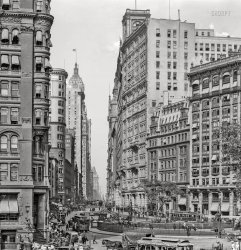
- Breaker Boys: 1911
- January 1911. Breaker boys in #9 Breaker, Pennsylvania Coal Company mine at ... Posted by Dave - 07/24/2012 - 6:59pm -
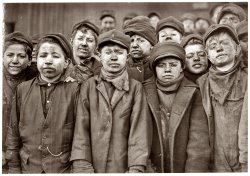
- Sailors Platter: 1911
- June 22, 1911. "Navy Yard, New York. U.S.S. North Dakota messmen being served from ... Posted by Dave - 05/19/2012 - 10:17pm -
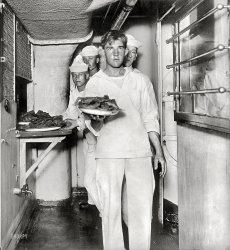
- Carrying-In Boy: 1911
- June 1911."Carrying-in" boy in Alexandria Glass Factory, Alexandria, Virginia. Works ... Posted by Dave - 08/15/2012 - 9:47am -
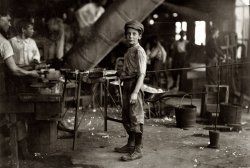
- Broad Street: 1911
- Charleston, South Carolina, circa 1911. "Broad Street looking west." 8x10 inch dry plate glass negative, Detroit ... by Thompson and Frohling of New York and built in 1910-1911. Today it houses condominiums. In the distance at the left can be seen the ... Posted by Dave - 05/01/2014 - 8:05am -
![Broad Street: 1911 Charleston, South Carolina, circa 1911. "Broad Street looking west." 8x10 inch dry plate glass negative, Detroit Publishing Company. View full size.
What is this thing?Hearse? Food cart?
[Delivery van for the Jet-White steam laundry. - Dave]
No Google Street View HereInterestingly, Google does not have street view for this part of Broad Street. The drug store on the right was razed, and is now a Wachovia (soon to be Wells Fargo). Also, the tall building on the right is now lacking the wonderful cornice detail it once had.
Non-clearance CurveThe CARS PASS HERE sign likely refers to the fact that if streetcars travelling in opposite directions attempted to pass each other on the curve, they would collide.
Cars PassThe Cars Pass here sign is not uncommon on older streetcar systems that have upgraded from the short 2 axle cars to longer 4 axle ones.
The problem, that cities found, was that the existing trackwork didn't always have the best clearances. Where two shorter cars may pass fine on such a curve, longer cars would often over hang and strike each other. Since most (not all of course) streetcar systems worked on "sight" or without signals with the motormen maintaining safe distance on their own based on what they see, you would often find signs like this near pinch points. Basically what it tells the motorman is that if they saw another car (there should be a mirror somewhere on a building for this) that the driver was to stop and wait for the car to pass him before starting forward.
CARS PASS HEREPerhaps the sign refers to the crossover track below.
On another subject, the cigar store Indian brings to mind a question - what's the reason for that association that was so common in those days?
[Indians introduced tobacco to the white man. - Dave]
Walker-EvansWho knew he was a stationer at the age of 7?
Tonics for the NervesVigorone and Coca Celery.
Broad ViewSo many details about life a century ago are in this picture:
1. Utility poles are not 100% straight and still have the knots from where their branches once grew.
2. Those poles are planted in the street, amid the cobblestones. They are also inventoried and labeled by their owner (as if pole rustling was a problem back then).
3. The Indian not only has wheels, he has a custom box to stand on--again out in the street. Likewise the postcard/cigar/soda water sign. And if you have a barrel full of whatever is in that barrel, put it out beyond the curb too. The street is not for transportation. It is part of the front yard of the stores.
4.Repainting signs is not important. Everyone knows where Folio Bros Cigars and Carolina Building Material are, so no need to keep the sign from fading or peeling.
5. You can park your car on either side of the street, facing either direction. Just be sure to look before you step out, so you don't step in any equine by-products.
6. Lots of mounting blocks and hitching posts for those horses.
7. Next to the Walker Evans pole is a great place to hang out and socialize.
8. The middle of the street is a good place to walk along.
9. It is very much a man's world. I see only one women and no children along the entire street.
Utility PolesThe reason that the utility poles are numbered is to keep track of maintenance and alterations. Also, in some areas back then there might well be a difference as to who was responsible for the electric power and the telephone poles (vs one leasing space on the other). Most of the overhead clutter of wires and crossarms was before multi-conductor telephone cables were developed.
Buildings of NoteThis view is taken from the foot of Broad Street at East Bay Street. The tall building on the right is Charleston's first skyscraper, the People's National Bank Building; it was designed by Thompson and Frohling of New York and built in 1910-1911. Today it houses condominiums. In the distance at the left can be seen the tower of St. Michael's Church, built 1752-1761 and still standing at what Charlestonians call the "Four Corners of Law" (the intersection of Broad and Meeting Streets).
+99Below is the same view from July of 2010.
(The Gallery, Charleston, DPC)](https://www.shorpy.com/files/images/SHORPY_4a25339a.thumbnail.jpg)
- Take a Letter: 1911
- May 22, 1911. "Buhl Stamping Co., Detroit, Mich. Office from inside." Last seen here ... Posted by Dave - 03/28/2022 - 4:27pm -
![Take a Letter: 1911 May 22, 1911. "Buhl Stamping Co., Detroit, Mich. Office from inside." Last seen here, from across the counter. Office-Boy, finally off the phone, is now on the filing cabinet, while Miss Shorthand has changed desks to take some dictation. 8x10 inch glass negative. View full size.
Married to EileenJudging from his posture in these photos, I'd guess the Office Boy is named McLean.
What this place really needs... is an Office Christmas Party.
What in tarnation?Is that contraption on the pillar?
[Fire alarm. - Dave]
Housekeeping in the teensI am always amazed at how filthy the floors are in these old pictures. How hard is it to run a mop over it? 10 minutes a day right before closing wouldn't cost anything. The rest of the place is pretty tidy, it's like they just don't see it.
[The was the factory office where the workers tromped in for their paychecks. Mopping happens after these folks go home for the night. And: That might not even be dirt, but where the finish has worn off the floorboards. - Dave]
Electric meter IDVisible through the doorway, high on the brick wall, appears to be a Fort Wayne Type K, with the top terminal block option.
The anchorSliver of the lit floor coming through the door is the key to the composition.
(The Gallery, Detroit Photos, DPC, The Office)](https://www.shorpy.com/files/images/SHORPY-4a21083a.thumbnail.jpg)
- Occoquan: 1911
- Fairfax County, Virginia, circa 1911. "Occoquan Work House, sleeping area." Part of the jail operated by the ... Posted by Dave - 08/28/2012 - 6:37pm -
![Occoquan: 1911 Fairfax County, Virginia, circa 1911. "Occoquan Work House, sleeping area." Part of the jail operated by the District of Columbia Department of Corrections, shown shortly after its construction. Harris & Ewing glass negative. View full size.
Then and NowThe prison was closed down the 1990s, and the low security dorm shown in this photo has been converted into an center for the arts and a museum -- quite a change!
http://workhousemuseums.org/
Love the track lightingI think it fits the decor.
The exteriorof another part of this charming facility. Click to embiggen.
"Occoquan Work House, exterior." (Harris & Ewing)
The beds don't look too comfybut it's clean, there's heat and lots of natural light. I can think of worse places to be locked up. I'm guessing these guys were minimum security types.
The well-read inmateAt least one inmate here reads the Washington Post. Today the workhouse is an arts center:
http://www.workhousearts.org/
The Work HouseWhat exactly was a Work House? Sounds like something out of Charles Dickens.
I worked there.I was employed by the Department of Corrections for over ten years starting 1971. The workhouse, at least in those days, was simply the minimum security facility of Lorton Reformatory. The DCDC had five facilities in Lorton, Virginia.
Maximum Security (the Wall, where I ate lunch every day for a dollar), Big Lorton (Central Facilities), the Workhouse (or Occoquan - never actually called Minimum Security).
There was also YC1 and YC2, both Youth Centers. I started as a Correctional Office at YC2, then worked in the Industries Division at Central for 10 years. Many a time I have walked the sweltering underground tunnels connecting YC2 to the steam plant at Occoquan.
Occoquan was where an inmate could hope to graduate to, from Big Lorton, when nearing his parole and escape risk was very low. Inmates at the workhouse could be truck drivers' helpers, or any number of jobs at the facilities, and earned a small salary which would help a lot when paroled.
I could write a book about all that went on in Lorton, and am always thrilled to see old photos.
Here is one of One Tower and the Salleyport at the Wall. It was never called the Citadel.
Really this is is exterior view of same building?The interior view seems to be of a much wider building. For instance there seems to be space for 4 rows of beds with additional room for 2 wide corridors, one in each of the bays. Also the windows in the interior view seem to start at least 10 or maybe even 11 feet above the floor.
[As noted in the captions, the interior shot shows the workhouse dormitory and the outdoor shot shows the workhouse. - Dave]
Outdoor & Indoor Shots?The more I look at the two photos, the more i think they are two separate buildings. The interior space, height of the windows from the floor ...
[As noted in the captions, the interior shot shows the workhouse dormitory and the outdoor shot shows the workhouse. - Dave]
More elevated steamAnother photo showing radiators 5 feet or more off the floor. First time I saw this was from another Shorpy picture of an auto repair shop. Only times I have ever seen this.
SimilarThis shot reminds me a lot of these Civil War images. Aside from steam radiators and electric lights, there's not much difference.
https://www.shorpy.com/node/2388?size=_original
https://www.shorpy.com/node/2384?size=_original
Been there, done thatSpent two nights there with Mr. Chomsky and Mr. Mailer back in '67. Good place to plan the Revolution.
(The Gallery, Harris + Ewing)](https://www.shorpy.com/files/images/20471a.thumbnail.jpg)
- Stacked Decks: 1911
- New York. June 21, 1911. "White Star liner S.S. Olympic guided by tugboats Kirkham and ... Posted by Dave - 08/13/2012 - 7:27pm -
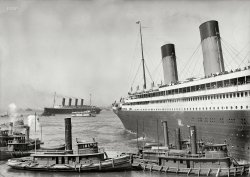
- Fifth Avenue: 1911
- New York circa 1911. "Fifth Avenue at West 43rd Street." 5x7 inch dry plate glass negative, ... Virtually everything in this photo has been changed since 1911, with the exception of St. Patrick's Cathedral, the twin spires of which ... the one in the photo. Perhaps it was moved sometime after 1911? One final note: if this photo had been taken just 5-7 years earlier, the ... Posted by Dave - 09/08/2017 - 1:29am -
![Fifth Avenue: 1911 New York circa 1911. "Fifth Avenue at West 43rd Street." 5x7 inch dry plate glass negative, Detroit Publishing Company. View full size.
Right-hand drive?So early on the US had right-hand drive cars? Very interesting, would love to know the history surrounding the change.
[A situation often noted in Shorpy photos; in the words of Dave, "Cars of the era were a mix of right- and left-hand-drive. By 1920, most auto makers had settled on left-hand drive." -tterrace]
From wherewould this photo be taken?
[I think a couple of them are heading down the street on the right. -tterrace]
Looking northThis is a view looking north on Fifth Avenue. Virtually everything in this photo has been changed since 1911, with the exception of St. Patrick's Cathedral, the twin spires of which appear in the distant haze on the right. There is today, however, a big pedestal clock on the same (west) side of Fifth Avenue, one block north of its location in the old photo. You can see it on Google Maps, and all of the filigree and other details on the clock appear to be the same as the one in the photo. Perhaps it was moved sometime after 1911? One final note: if this photo had been taken just 5-7 years earlier, the horses and buggies would still have greatly outnumbered the automobiles, even in midtown Manhattan. But by 1911, the tide had clearly turned.
(The Gallery, Cars, Trucks, Buses, DPC, NYC)](https://www.shorpy.com/files/images/SHORPY-4a27525a1.thumbnail.jpg)
- Breaker Boys: 1911
- January 1911. South Pittston, Pa. "Breaker boys working in Ewen Breaker of Pennsylvania ... Posted by Dave - 09/21/2012 - 10:28pm -
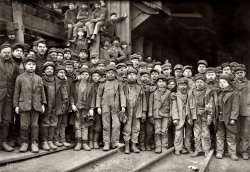
- Executive Branch: 1911
- Circa 1911, our second selection from the panoramic series "Washington from ... This set of panoramic shots, depicting Washington DC in 1911, is an incredible example of where this website excels in bringing history ... for future generations to ponder.
Now, if I only had a 1911 Rand-McNally...
[Unfortunately, any records of the photographers ... Posted by Dave - 04/10/2014 - 1:41pm -
![Executive Branch: 1911 Circa 1911, our second selection from the panoramic series "Washington from Washington Monument." Landmarks include the State, War & Navy Building at left; the White House and Ellipse; and U.S. Treasury. 8x10 inch dry plate glass negative, Detroit Publishing Company. View full size.
Things Sure Have ChangedThere's a lot more trees and a much bigger fence around that side of the White House today. In fact when we were there in 2009, we saw a secret service person all dressed in black lurking in the trees with a machine gun.
I spy...... The Cairo, at about 1 o'clock from the White House.
Where Shorpy excelsThis set of panoramic shots, depicting Washington DC in 1911, is an incredible example of where this website excels in bringing history to life. I only wish I had a larger screen on which to relish this photo.
Of course, we should also credit the original photog(s) who captured the scene for future generations to ponder.
Now, if I only had a 1911 Rand-McNally...
[Unfortunately, any records of the photographers employed by the Detroit Publishing Company or who made specific exposures have apparently not survived. -tterrace]
+93Below is the same view from July of 2004.
SundialAnyone know what happened to the sundial where the south fountain is or was it just trashed?
Panoramic is really great.This series is really fantastic. I've found the first three of this series but can't seem to locate 4, 5 and 6. The Sumner School (17th and M Street) jumps out at me left of center because that's exactly what I see square on from my office window.
(The Gallery, D.C., DPC, Sports, Streetcars)](https://www.shorpy.com/files/images/SHORPY_4a10392a.thumbnail.jpg)
- Uneeda Biscuit: 1911
- Detroit circa 1911. "National Biscuit Co." Manufacturers of the once-ubiquitous Uneeda ... Posted by Dave - 03/25/2022 - 2:30pm -
![Uneeda Biscuit: 1911 Detroit circa 1911. "National Biscuit Co." Manufacturers of the once-ubiquitous Uneeda Biscuit as well as its obliviated sibling, the Uneeda Jinjer Wayfer. (Proximity notwithstanding, something tells us that no amount of glib sloganeering will ever turn Byers Full Weight Wrought Iron Pipe into an impulse purchase.) Detroit Publishing glass negative. View full size.
Shorpy is my daily time travelI love this website. Notice the slightly less concise version of "Got Milk?" -- "Do you know Uneeda Biscuit?"
Ubiquitous ... or "ubiscuitous" ??If you were patient and hung around, the next year — i.e. 1912 — you could have a package of "Leap Year Jumbles" (Hopefully NOT available in a titanic-sized box)
And if you were really patient, and hung around for 17 years, you'd see this block (of Woodbridge Street) demolished to provide the entrance for the Detroit-Windsor Tunnel.
Byers PipeWas a product of the A.M. Byers Company in Pittsburgh. Here's a photo of the still standing Byers Mansion - actually two dwellings, one for him, one for his daughter's family - on the former Allegheny City Millionaires' Row. Note the wrought iron gates.
Look Ma, no wires!It's interesting in some photos showing downtown scenes, you see overhead wires crisscrossing all over the place but in the last few Shorpy pictures, you really don't see any! I guess they were buried under the streets.
[There's a smattering of wires here that the Detroit Publishing people retouched out of the negative. - Dave]
Marketing issue resolvedGottaHava Cast Iron Pipe.
(The Gallery, Detroit Photos, DPC, Factories)](https://www.shorpy.com/files/images/SHORPY-4a21050a.thumbnail.jpg)
- Galahad: 1911
- 1911. Washington, D.C. "Football. Georgetown University Game." Harris & ... Posted by Dave - 08/04/2012 - 2:24am -
![Galahad: 1911 1911. Washington, D.C. "Football. Georgetown University Game." Harris & Ewing Collection glass negative, Library of Congress. View full size.
The Shadow KnowsWhat makes this one is the shadow of someone's head (the photographer's?) on his pants. Otherwise, everyone seems wise to be giving this guy his personal space.
Team PlayerThis guy could walk right into any modern men's ad--Armani, Calvin K, you name it.
Rugby RootsNo doubt why the forward pass hadn't yet caught on with these earlier teams. It'd take a current NBA guy to get his hand around that football. Really shows football's roots in rugby, since their ball is still about that size and shape.
Handsome Rake CandidateHubba hubba! With a side of yowza.
[Something tells me he might be a little old for you, but what the hay. - Dave]
Re: team playerYeah! You have right. I also look the faces of the past, to search persons, who can walk in the present without any differences. This guy can be a celeb in 2008 but maybe in 1920 he wasn't look good extremely, because the trend idea.
Whoa"Galahad" indeed. Yowza. Talk about a smoldering stare.
(The Gallery, D.C., Handsome Rakes, Harris + Ewing, Sports)](https://www.shorpy.com/files/images/00458a.thumbnail.jpg)
- Raymond Bykes: 1911
- ... envelope than anything else. Photo by Lewis Wickes Hine, 1911. View full size
The Bicycle Bicycle design and geometry hasn't ... Posted by Ken - 08/13/2013 - 3:37pm -
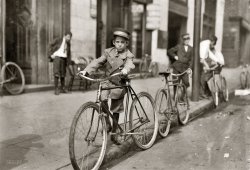
- A Banner Day: 1911
- Cleveland, Ohio, circa 1911. "Public Square -- Cuyahoga County Soldiers' and Sailors' Monument." With ... not newspapers. - Dave]
Hometown Pride Yep, the 1911 date is right there. Time of day via shadow length seemed like late ... Posted by Dave - 01/23/2018 - 10:12pm -
![A Banner Day: 1911 Cleveland, Ohio, circa 1911. "Public Square -- Cuyahoga County Soldiers' and Sailors' Monument." With flags and bunting much in evidence. 8x10 inch dry plate glass negative, Detroit Publishing Company. View full size.
A Newfangled Auto? Who Needs One!I count at least 15 streetcars in one photo. Maybe I missed a couple.
StreetcarsThere are quite a few streetcars in this scene. I love the May Company building on the far right.
Accident?What's going on in front of the streetcar on the left side middle? It looks like a crowd of people gathering, and the wagon next to it seems to have dumped its load all over the street. Maybe someone got hit?
A newspaper feeding frenzy?I interpret the gathering around the wagon with half its load on the ground as a delivery of newspapers. The small crowd has gathered to buy the latest edition "hot off the press."
Those were the days of newsboys selling right on the streets!
The Shorpy Sleuths can tell us if it's a morning, afternoon, or evening edition by studying the shadow patterns.
[Whatever it is, it's not newspapers. - Dave]
Hometown PrideYep, the 1911 date is right there. Time of day via shadow length seemed like late afternoon but squared up by a view of the clock on the May Co. building in the upper right: 3:10 p.m. The bunting is for a D.A.R. reunion that summer.
Large stone building in the center was completed 1910 and is extant. The Soldiers' & Sailors' Monument (center right) was completed in 1894 and is also still standing, even after a recently finished redo of the whole of Public Square.
Here's a Shorpy photo from the opposite direction 11 years earlier: https://www.shorpy.com/node/17589
Keep up the good work ... yer feeding my habit !
15 StreetcarsAnd not a single one named Desire I'd bet.
Hey 19is my streetcar count. With that many, it would be no problem to get around! I lived in San Francisco for a while, and could get within three blocks of anywhere in the city by bus or streetcar. Then moved to Grand Rapids, Michigan, where you were extremely lucky if you could get within two miles of where you wanted to go. If Grand Rapids was anything like this scene, I'd have never needed a driver's license!
Wayward Implements"I am so tired of carrying this ladder. That's it, I quit."
A Small Bit Of Trivia...Down in the lower left hand corner of the picture would be where Ralphie and his family watch the Christmas Parade in the film, 'A Christmas Story". And also, the four squares that make up Public Square in this picture have been remodeled into two large ones; Ontario Avenue no longer goes all the way through the square.
CEICºThe Cleveland Electric Illuminating Co. had his offices in one of the buildings in the middle, at 75 Public Square.
Here's a square related to them:
(The Gallery, Cleveland, DPC, Patriotic, Streetcars)](https://www.shorpy.com/files/images/SHORPY-4a25315a.thumbnail.jpg)
- New Jersey Zinc: 1911
- Paterson, New Jersey, circa 1911. "American Locomotive Co. Rogers Works. 0-4-0 locomotive for New Jersey ... Posted by Dave - 06/21/2016 - 10:54am -
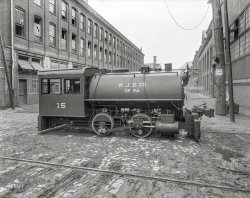
- Cigarette Girl: 1911
- June 1911. Ethel Shumate. Has been rolling cigarettes in Danville (Virginia) factory ... Posted by Dave - 02/10/2010 - 7:14am -
![Cigarette Girl: 1911 June 1911. Ethel Shumate. Has been rolling cigarettes in Danville (Virginia) factory for six months. Lives at 614 Upper Street. Said she was 13 years old, but it is doubtful. View full size. Photograph and caption by Lewis Wickes Hine.
BillboardWhat does the bottom of the Coca-Cola billboard say?
[5¢ relieves fatigue sold everywhere - Dave]
Ethel's ageThe 1910 census lists Ethel as 12. She's listed as the first child of James C. and Lucy L. Shumate living at 614 Upper St.
Horse Trough?What is that next to the fire hydrant? A public trough for horses maybe?
Horse TroughIt's awfully shallow for a trough, at least from this angle, but that's what I thought it was, too, since they had them then. I'm thinking now it is a spittoon or a place to dispose of cigarette/cigar butts. This was the era you would see "Don't spit" signs on the streetcars; not only was it dirty, but it spread tuberculosis.
[It's a cast-iron horse waterer, with plumbing. Somewhere around here I have a picture showing it being used. - Dave]
Ethel Shumate 1898-1981The Social Security Death Index shows an Ethel Shumate, born on 28, Jan 1898, which would have been this girl's birth year according to the 1910 census, who died January 1981 in Flint, Michigan. There are only nine Ethel Shumates listed so it is likely her. Perhaps she never married or was divorced.
She Was Telling The Truth All Along.So, while the photo's caption sat around for 100 years with Hine's proclaiming Ethel's age of 13 was "doubtful", we know now that she was telling the truth all along! Rest in peace Ethel!
[Lewis Hine was frequently "doubtful" in his caption notes as to whether these kids were as old as they said they were. But for every name we or our readers have been able to check in the Social Security Death Index, the "doubtfuls" all turn out to have been telling the truth, Shorpy himself among them. - Dave]
(The Gallery, Kids, Lewis Hine)](https://www.shorpy.com/files/images/04742u.thumbnail.jpg)
- Cutting Crew: 1911
- August 1911, Eastport, Maine. All these boys are cutters in the Seacoast Canning Co., ... Posted by Dave - 12/10/2007 - 2:11pm -
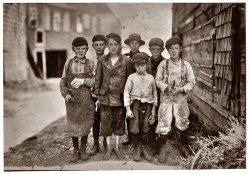
- Purdie Family: 1911
- Matoaca, Virginia. June 1911. "Lawrence Purdie (right end) has been spinning in the mule room of the ... lived there with him. Another little brother (Miland, b. 1911) also appears. Joseph Early is living with his in-laws and has a daughter ... Posted by Dave - 09/08/2011 - 5:42pm -
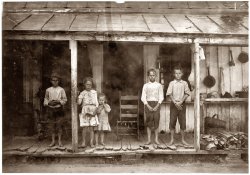
- Works All Day: 1911
- ... a cannery." Location unspecified but possibly Mississippi. 1911. View full size. Photograph by Lewis Wickes Hine.
It is Haunting ... Posted by Dave - 08/19/2012 - 9:37am -
![Works All Day: 1911 "The girl works all day in a cannery." Location unspecified but possibly Mississippi. 1911. View full size. Photograph by Lewis Wickes Hine.
It is HauntingI agree with Dave
Creepy music is playing inCreepy music is playing in the background...
PowerfulWhat an incredibly powerful photo. I am at a loss for words.
[I feel the same way. It's my favorite of the past week, even though it got the fewest views of the 10 I posted that day. - Dave]
WowThat is a lovely show of freckles. She has a wonderful face. Too bad we can't find out who she was and what she accomplished.
Her Face Jumps Out of the PictureThe way he focused on the plane of her face, with her body in low focus and the background completely obscured creates an amazing effect.
The window to the soulHer eyes say it all. A wonderful fascinatingly powerful image. I wonder what became of her?
PersonalizedI'll bet she did that hand embroidery and applique in her spare time. Possibly to personalize a hand-me-down from an older sibling.
(The Gallery, Kids, Lewis Hine)](https://www.shorpy.com/files/images/SHORPY_00887u1.thumbnail.jpg)























